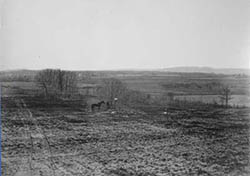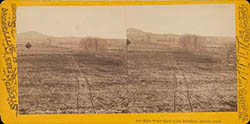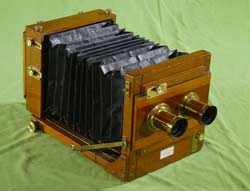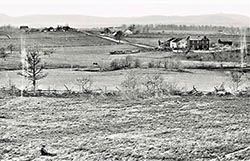In the spring of 1882, Battle of Gettysburg Cyclorama artist Paul Philippoteaux hired local Gettysburg photographer William H. Tipton to take a panoramic series of battlefield photographs from a raised platform at a point near the “Copse of Trees” on Cemetery Ridge. The conventional cyclorama practice would have his assistants draw a circle around the platform, eighty feet across, with stakes driven into the ground dividing the view into ten sections. Tipton would then have made three pictures, stacked vertically, of each section, focusing on the foreground, the level view, and then a view tilted up toward the horizon. However, if Tipton did indeed follow this conventional practice, we’ve been able to locate only the ten level-view images. If you have any information regarding the “missing” 20 photographs from the panorama, please use the comments section below.
William H. Tipton Photographs: A Discussion
The large image below is an experiment that compares two William H. Tipton photographs. One (left) is image #2 from the 10-shot panorama. The other (right) is the “High Water Mark of the Rebellion—Bloody Angle” stereoview (#528), which Tipton made at the same time as the panoramic sequence.
Enlarged details from the two Tipton photographs have been combined as an experiment. Both images have been modified for enhanced detail, and then aligned, but otherwise unaltered. On a desktop or laptop move your cursor over the large image below to view the stereoview detail, and out of the image to view the plate view detail. This experiment may suggest a few questions, detailed in the section below the photograph.

Move your cursor into the image to switch views. Will not work on phone or tablet.
It is clear from the experiment (above) that the two photographs were made from exactly the same camera position, and almost certainly with the same focal length lens. The only significant difference between them is that the man pointing, the horse, and the prostrate figure were all absent from the scene when the stereo was made. Other slight discrepancies may be ascribed to shadows moving due to the interval between the making of the two images, as well as wind-blown branches and vegetation. Our page with the stereoview may be seen here.
We’ve have been unable to determine which make/model of camera Tipton was using for this work. But it’s likely that the camera was a glass-plate model, similar to the one to the left, with a removable lensboard. It’s probably that the dual-lens front lensboard could readily be replaced with a single-lens lensboard. If you click on the image of the c. 1875 camera (left) to enlarge the image, you’ll note that the lensboard is held in place by a single latch on its top edge.
It also may be possible that all ten images were photographed using stereo plates. Tipton could have made prints from either the left or the right side of each plate to provide Philippoteaux with the ten prints required for designing the cyclorama painting.
It seems highly unlikely that the images could so perfectly align if Tipton had removed the heavy wooden two-lens camera from his tripod and replaced it with a different, single lens camera.
Is there any way to confirm the details about his camerawork methodology? Access to the negatives would be helpful in this regard. Apparently the original negatives are with the National Archives.
Also… what does the sign say? It’s illegible in these images, even after an attempt at enhancement. Due to the location, it might have said “High Water Mark of the Rebellion,” or “Bloody Angle.” Or perhaps it was one of the signs marking brigade positions? Maybe “72nd PA Infantry.”
And… why was this specific spot one of those where Tipton/Philippoteaux directed one of their assistants to position himself as a fallen combatant? Was this simply to assist the painter in his perspective studies, or was the “dead body” intended to suggest the location of a specific battle casualty?
If you wish to respond to any of these questions, or if you wish to raise any issues of your own, please use the comments section below.
Tipton created at least one additional stereoview while working with Philippoteaux, corresponding to image #3 in the series of ten in the panorama. This pair, apparently never published as a stereocard, may be viewed here in our gallery of 3D images.
Frassanito (1995) writes on p. 240: “Taking advantage of the platform constructed for the project, Tipton produced two stereo versions roughly corresponding to two of the ten plates [made for Philippoteaux]; the stereo forming a limited panorama depicting the clump of trees in one, and the Cordori farm buildings in the other. Although it is not clear whether Tipton ever formally issued the Cordori farm version (the glass negative in the Tipton Collection does not bear an original negative number), the clump-of-trees stereo was eventually issued as #528…”
Frassanito’s description of the two stereoviews forming “a limited panorama” may not, strictly speaking, be accurate. While there may be more complete scans elsewhere, the images shared with us do not overlap, or even abut one another in a manner suitable for creating a seamless panorama







Steve Lindberg
Posted at 19:00h, 17 MayHello,
I have been looking at this website and panoramic views, along with narrative with great interest! I have a question; is the Evergreen Cemetery gatehouse the struture visible in the background when I scroll around approx. 180 degrees from ” the angle”? A structure is visible but blurry.
Thank you,
Steve Lindberg
Philippoteaux
Posted at 17:34h, 24 JuneI’m sorry, but I’m not able to identify the structure either.